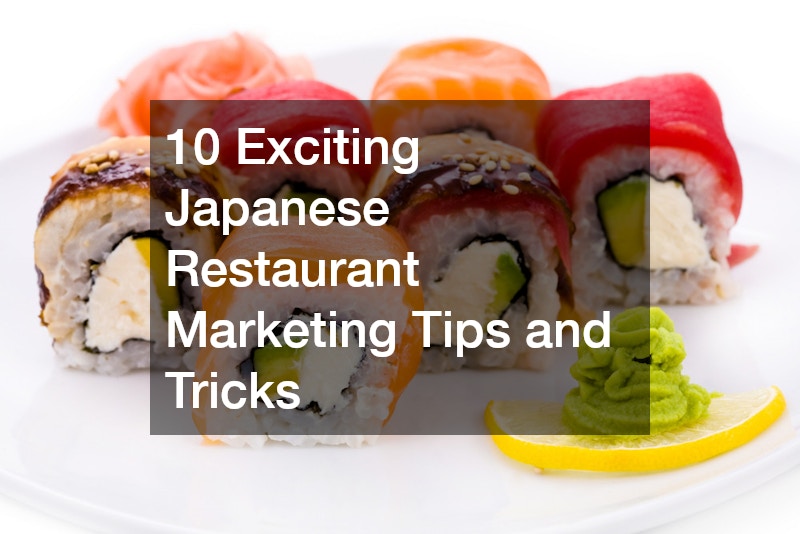Standing out in the competitive dining industry today requires more than just serving good food—it takes strategy, innovation, and a strong sense of identity. This is especially true for establishments offering Japanese cuisine, which combines tradition, artistry, and cultural nuance in every bite. To thrive in this unique niche, it’s essential to apply smart restaurant marketing tips that help translate your culinary excellence into a compelling brand experience. From visuals to messaging to service delivery, every detail should reflect the sophistication and authenticity your guests expect.
With so many options available to diners—from street-side ramen counters to upscale omakase destinations—there’s a real need to consistently connect with your ideal audience. Every decision, from how you design your menu to how you present your dishes online, influences perception and builds loyalty. Even the seemingly small details, such as how your team interacts with guests or how often you post new updates to your online platforms, play a critical role in defining your place in the market.
You’ll learn actionable ways to present your offerings with impact, gain trust from your audience, and maintain the momentum you need to thrive. While each tactic stands on its own, together, they form a cohesive marketing approach rooted in thoughtful execution and real-world success. Let’s dive into these exciting, practical strategies designed to elevate your presence and performance in today’s dynamic dining world.
1. Elevate the Flavor

Creating an unforgettable culinary experience starts with the food itself. Guests are more likely to return—and recommend your space—when they remember the depth and richness of each dish. Flavor development, authenticity, and balance all contribute to the overall satisfaction and emotional response that keeps diners talking. Beyond taste, how a dish is plated and described helps position your brand as either casual, contemporary, or traditional. First impressions matter, and your menu is often your most powerful ambassador.
If you operate a restaurant that wants to build a reputation for excellence, you must carefully curate your dishes to match your identity. This means sourcing high-quality ingredients, fine-tuning recipes, and even taking into account seasonal availability to surprise guests with timely specials. Signature items can also be developed to create a unique connection with customers—something they can’t find anywhere else. These types of custom touches are especially valuable when developing your marketing messaging and brand story.
Incorporating restaurant marketing tips into this process can elevate your brand image across multiple platforms. From highlighting your top dishes in promotional photos to explaining the origins of specific ingredients, you’re giving your audience more than just a meal—you’re offering insight into your values and craft. With the right approach, even a simple dish can become a symbol of your expertise, helping you stand out in a crowded marketplace.
2. Roll Out the Style
Visual appeal is a major draw when it comes to Japanese food, and few dishes embody that better than the sushi roll. The intricate layering, vibrant colors, and clean cuts create an edible work of art that naturally lends itself to high-impact promotion. Capitalizing on the visual elegance of these offerings is one of the smartest ways to generate buzz and attract attention on both social media and review sites.
To make the most of this opportunity, it’s important to develop a strong aesthetic approach. Lighting, plating techniques, and serving ware all contribute to the final look of your sushi roll. Consider curating a photo-friendly corner of your dining space or working with a food stylist to craft visuals that pop on screen. Promoting these images through the right channels can increase engagement significantly and spark curiosity.
Using proven restaurant marketing tips, you can go even further by integrating customer photos, holding themed nights, or introducing interactive experiences like build-your-own sushi rolls. These strategies not only deepen engagement but also give your diners a chance to participate in your brand story. A sushi roll may start as a dish, but with the right style and messaging, it becomes a powerful marketing tool.
3. Freshness First

In any dining concept centered around ocean-sourced dishes, freshness is more than a preference—it’s an expectation. Guests who seek out a seafood-focused experience at a sushi bar want to be assured that what’s served is both safe and of the highest quality. This puts additional pressure on business owners to ensure proper handling, sourcing, and presentation, but it also presents a significant branding opportunity.
As a seafood restaurant, you have a natural advantage in promoting freshness as a defining trait. Sharing sourcing practices, catch-of-the-day features, and partnerships with trusted fishmongers or markets adds credibility to your message. Use language that highlights care, timing, and transparency. Seasonal updates and rotating selections can further showcase your commitment to offering only the best ingredients.
Restaurant marketing tips tied to freshness include running limited-time campaigns based on available catches, behind-the-scenes videos of prep work, or even blog posts highlighting sustainability efforts. This kind of storytelling builds confidence with your audience and makes the quality of your food part of your brand identity. When freshness becomes your signature, your visibility and customer loyalty naturally increase.
4. Plan with Purpose
A thriving dining establishment doesn’t succeed by chance—it grows through thoughtful intention and future-focused decision-making. Strategic planning involves assessing your current operations, setting clear goals, and identifying measurable ways to achieve them. Without this foundation, even great ideas can fall short due to a lack of structure or alignment. This is especially important in the hospitality industry, where trends shift quickly and guest expectations constantly evolve.
By implementing business strategic planning, you can identify what marketing approaches have worked in the past and which areas need improvement. Strategic planning gives you data-driven insights to guide those choices and adapt effectively. It also helps you stay proactive rather than reactive, allowing you to anticipate slow seasons or capitalize on holidays with precision.
One of the best restaurant marketing tips related to planning is to develop a yearly or quarterly calendar that includes key promotions, events, and content strategies. Aligning your efforts around a solid roadmap makes it easier to delegate tasks, track progress, and evaluate success. Strategic planning brings discipline to your marketing, ensuring that every move supports your bigger vision rather than being a one-off effort.
5. Polish Your Online Look

Your online presence is often the first impression potential diners get, and a poorly maintained digital front can instantly drive them away. No matter how great your food or service is in person, if your site is outdated, slow, or inaccurate, people are likely to move on. That’s why staying on top of technical upkeep and visual presentation is critical to staying relevant and trustworthy.
Routine website maintenance ensures that your pages load quickly, images look sharp, and all information is up to date. If you allow online reservations or takeout orders, these features must be tested regularly to avoid disruptions. Design also matters: clean layouts, enticing food imagery, and mobile optimization all work together to create a seamless browsing experience that mirrors your in-person vibe.
A core restaurant marketing tip here is to treat your website like an extension of your space. Regularly update photos, publish seasonal announcements, and incorporate calls-to-action that invite people to engage. A polished online look doesn’t just impress—it converts interest into action, drawing new customers in and encouraging loyalty from returning ones.
6. Ask, Earn, Repeat
Word-of-mouth has gone digital, and online feedback now has the power to influence a diner’s choice more than ever before. Whether it’s a five-star shout-out or a nuanced critique, reviews serve as modern-day referrals that can shape your reputation for better or worse. Harnessing this feedback strategically is vital for growth.
Encouraging happy guests to leave reviews can significantly boost your credibility. This means creating subtle but effective reminders—whether through table cards, follow-up emails, or even gentle in-person requests. It’s also important to respond to feedback, both positive and negative, in a timely and respectful manner. Doing so shows attentiveness and a commitment to improvement, which goes a long way with potential customers.
Using restaurant marketing tips, you can take reviews a step further by turning them into promotional content. Feature standout testimonials on your website or social media, or use recurring compliments to inform future campaigns. Reviews give you real insight into what your guests value most, offering you a direct line to what works and where you can fine-tune your approach.
7. Refresh Behind the Scenes

A fresh, well-functioning kitchen is the hidden engine of a successful dining experience. While customers may never see the space where their meals are prepared, its condition directly affects food quality, safety, and speed of service. Modernizing your kitchen can have a powerful ripple effect on your entire operation.
Incorporating thoughtful kitchen updates allows your team to work more efficiently and with greater consistency. For example, energy-efficient appliances can save money, and updated prep areas can reduce wait times and improve workflow. These upgrades may also open up opportunities for new menu items or cooking techniques that align with seasonal trends or customer preferences.
One of the most practical restaurant marketing tips is to share what’s happening behind the scenes. Customers love transparency, and giving them a peek into recent upgrades—via social media posts or in-house signage—can foster trust and excitement. It signals that you invest in quality and care, and this message often resonates louder than flashy advertising.
8. Feature What You’re Known For
Every eatery has that one dish that gets people talking, and in this cuisine, the spotlight often falls on expertly crafted sushi rolls. Highlighting your signature offerings can strengthen your brand identity and help you stand out in a competitive market. Showcasing what you do best keeps your message clear and your appeal strong.
When marketing sushi rolls, presentation matters. Consider how to visually elevate your plates for photography, since these images often drive engagement on social platforms. You might also introduce limited-time specials or chef’s creations that rotate monthly, building anticipation and urgency around your menu. These exclusives keep loyal customers returning while giving new visitors a reason to try something original.
For restaurant marketing tips that stick, lean into storytelling. Share the inspiration behind a signature roll or feature the sushi chef responsible for its creation. When you elevate your star dishes with intention and personality, they become memorable experiences that customers want to share and return to.
9. Bring in Expert Guidance
Even the most talented restaurateurs can benefit from an outside perspective. Bringing in a business consultant with hospitality expertise can uncover blind spots and provide strategic clarity you may not achieve alone. Consultants can help you assess operations, uncover opportunities, and craft a long-term plan for sustainable growth.
Working with a consulting professional might include reviewing your financials, staffing, menu pricing, or customer engagement strategies. These experts can identify inefficiencies, refine brand messaging, and offer tailored advice that fits your specific business size and location. They often come with industry benchmarks that help you gauge your performance compared to others in the field.
Among the most valuable restaurant marketing tips is knowing when to ask for help. Business consulting doesn’t mean giving up control—it means gaining insight to make smarter decisions. Whether you’re launching a new concept or revitalizing an existing space, experienced input can dramatically accelerate your progress and keep you on the right path.
10. Know Your Audience
At the heart of every effective campaign is a deep understanding of who you’re serving. From menu design to social media tone, everything should reflect what your audience values. When you know who your guests are, you can craft messaging and promotions that resonate authentically.
Identifying your target demographic involves more than guesswork. Analyze customer feedback, track sales data, and observe patterns in reservations or order types. This knowledge helps you time your specials, design your interiors, and even select your music. It informs everything from your pricing strategy to your community outreach, ensuring your efforts are well-directed.
For restaurant marketing tips that work, tailor every customer touchpoint—from your signage to your Instagram stories—to reflect your audience’s lifestyle and expectations. Being relevant isn’t about guessing trends; it’s about knowing your base and showing up in ways that matter to them. This level of personalization helps build loyalty and keeps your tables full.
Serving Up a Smarter Future
The landscape of the dining industry is dynamic, competitive, and increasingly digital—but that also means there are more creative ways than ever to connect with your customers and stand out. This blog, centered on 10 exciting Japanese restaurant marketing tips and tricks, provides a roadmap that blends foundational best practices with fresh strategies you can tailor to your specific goals.
By focusing on visibility, branding, and operations—from creating engaging visuals and enhancing ambiance to leveraging customer reviews and expert consulting—you’re building more than just a customer base. You’re building a strong, recognizable identity. Your signature sushi rolls and refined space tell part of the story, but how you share that story through strategic actions is what keeps people coming back.
Marketing a modern dining space, especially one rooted in Japanese cuisine, requires a balance of innovation and authenticity. By applying the strategies we’ve discussed across planning, design, service, and communication, you can position your space not just as a place to eat, but as a destination. With these 10 exciting ideas in hand, you’re not just keeping up—you’re leading the way.




